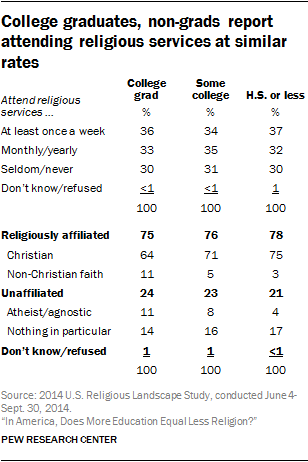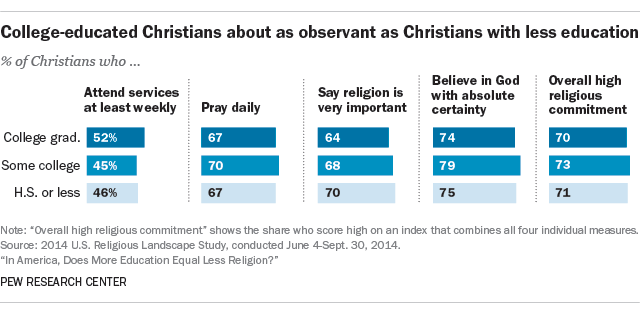It depends. In a recent article in the Journal for the Scientific Study of Religion, sociologist Philip Schwadel finds that the effects of education depend on religious context during adolescence:
Results show that higher education is particularly likely to lead to religious decline for mainline Protestants and those with religiously active parents, and to increases in religiosity for the religiously unaffiliated and those with parents who infrequently attend religious services. Unaffiliated emerging adults and those from homes with parents who rarely attend religious services are, on average, less religious than other emerging adults, but, unlike most other emerging adults, they are likely to increase in their religiosity if they go to college. These findings demonstrate how the religious context in adolescence conditions the influence of education, both positive and negative influences (pg. 870).
In short, “the widespread view that education “erodes” religion (Johnson 1997) does not apply equally to all emerging adults, and the religious context in adolescence is one dimension along which it varies” (pg. 882).
This expounds on Schwadel’s previous work. For example, his 2016 article in The Sociological Quarterly found that “graduating from college is associated with declines in prayer, religious certainty, and especially religious belief during emerging adulthood” (pg. 778). However, he also found that “the highly educated are relatively likely to attend religious services. These results suggest that church pews are now disproportionately filled with college-educated young adults, many of who question key religious beliefs. This comports with a long tradition of sociological research (e.g., Fukuyama 1961; Roof 1976) that emphasizes that college students, and the college-educated more generally, often compartmentalize religion to weekend services and holidays (for more recent examples, see Campbell 2005; Clydesdale 2007)” (pg. 779).
When he did a 2015 cross-national analysis, Schwadel found that while those with university degrees had lower levels of religiosity overall, “sex, marital status, and age have considerably larger effects on religiosity than does higher education” (pg. 414).[ref]In a 2018 study, Schwadel writes, “On average, men are more likely than women, non-married are more likely than married, and young adults are more likely than the elderly to have no religious affiliation, but the extent and even existence of these differences varies from nation to nation. This comports with Hayes (2000) analysis of variation in the factors predicting non-affiliation across 10 Western, Christian nations. Going beyond Hayes’ analysis, the results here suggest that demographic differences in the likelihood of non-affiliation are most pronounced in nations with low levels of religious regulation… [H]igh levels of religious regulation are associated with lower levels of non-affiliation, and fewer differences by age, gender, and marital status as the potential consequences of non-affiliation are more severe in many of those nations” (pg. 267).[/ref] Furthermore, “the average level of higher education in each nation is not associated with individual religiosity” (pg. 414). In fact, GDP per capita has a much stronger, negative effect on religiosity than average levels of higher education. Most telling, however, is the fact that “the effect of university degree ranges from robustly negative to positive. The largest negative effects of university degree are in Israel (b = −.427) and Italy (b = −.409). University degree has a relatively strong, positive effect (b > .16) in Sweden, New Zealand, and South Korea. Overall, the effect of university degree is positive and significant (p < .05) in 9 nations, negative and significant in 18 nations, and has no significant effect in 12 nations” (pg. 411).

What’s more,
the negative effect of higher education on religiosity is more robust in relatively religious nations. This is evident both from the negative correlation between the random slope for university degree and the adjusted mean of religiosity (i.e., intercept), and from the positive interaction between university degree and the mean with no religion in each nation. These findings appear to support the diffusion argument that the highly educated are innovators and early adopters (Rogers 2003) of new ways of being religious (or irreligious) but that secularity then diffuses to the less-educated segments of the population. As Elias (2000) suggests in regards to attributes associated with the upper classes (e.g., manners), secularity may be a form of status differentiation for the highly educated in relatively religious nations, but it cannot serve that function in relatively irreligious nations (pg. 415).
All of this complicates the narrative of “more education = less religion.” Even Pew’s research from last year–which is often thrown out as evidence of the religiosity-killing nature of education–doesn’t vindicate the common narrative. While college-educated Americans are more likely to, say, identify as “atheist/agnostic”, their religious affiliation and church attendance is about the same as those who never finished/attended college.

For Christians with college degrees, their religious commitment is basically the same as Christians without them. In fact, the college-educated Christian is more likely to attend weekly religious services than their less-educated fellow devotees.

A 2007 study actually found that “it is the respondents who did not go to college who exhibit the highest rates of diminished religiosity. Those with the highest level of education – the respondents with at least a bachelor’s degree – are the least likely to curtail.their church attendance. They are followed by those with an associate’s degree, then by four-year college students, and then two-year college students. The most educated are also the least likely to report a decrease in religion’s importance, although those who attended college but did not finish also report low levels of decline in religious salience” (pg. 1677).[ref]The three dimensions of religiosity included (1) decline in religious service attendance, (2) decline in importance of religion, and (3) disaffiliated from religion.[/ref] The researchers also found that “cohabitors are the most likely individuals to report each type of religious decline,” while married persons “are the least likely to report each type of decline” (pg. 1677). Premarital sex and marijuana use was also associated with declines in religiosity. Schwadel’s 2011 study also found that education “has a positive effect on religious participation, emphasizing the importance of religion, and supporting the rights of religious authorities to influence people’s votes. Increases in education do not diminish devotional activities or belief in the afterlife, though highly educated Americans disproportionately lean towards belief in a higher power rather than definite belief in God” (pg. 178).
But does education at least lead to more liberal religious beliefs? A 2011 study found[ref]The measures of religious liberalization include (1) more unorthodox, (2) more naturalistic, (3) more uncertain, (4) more reserved when it comes to converting others, (5) more inclusive of other religious claims, (6) more individualistic, and (7) more independent of institutions.[/ref]
contrary to longstanding scholarly wisdom, attending college appears to have no liberalizing effect on most dimensions of religious belief. In fact, on some measures, college students appear to liberalize less than those who never attended college. College students are less likely to stop believing in a personal god and less likely to stop believing in the propriety of conversion attempts. On the other hand, they are more likely to develop doubts about their religious beliefs. In the main, however, the effect of college on students’ religious beliefs appears to be extremely weak. Although significant minorities of emerging adults become more liberal in their religious beliefs, college itself does not appear to be the culprit. College students do not liberalize any more than those who do not go to college.
In fact, the case for the null (and perhaps protective) effects of college on traditional religious belief is even stronger than it appears from these results. In supplementary analyses (not shown), college attendance also failed to predict differences on six other variables measuring religious beliefs. College students are also no more likely than non-students to stop believing in a judgment day, stop believing in an afterlife, stop believing in angels, stop believing in demons (except in the final two models, where social networks appear to suppress a positive effect of college attendance), become more uncertain about the existence of God, or abandon the belief that active congregational participation is a necessary aspect of being religious. Thus, on 10 out of 13 possible beliefs, attending college shows no net liberalizing effect before accounting for social networks; on two others, college appears to support traditional beliefs; on only one outcome – increased religious doubt – does college appear to undermine traditional religious belief. In the debate over how college influences religious beliefs, this study overwhelmingly supports those who claim that its influence is largely negligible, and perhaps even somewhat protective of traditional religious belief (pg. 199-200).
Basically, when it comes to education and religion, it’s complicated.